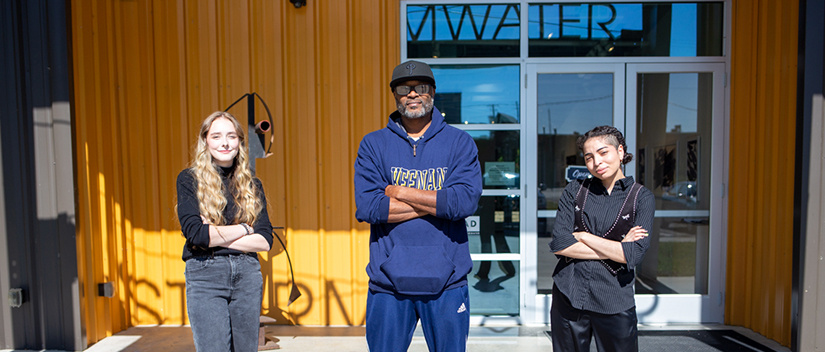Four undergraduate students in the School of Visual Art and Design are putting together an exhibition as part of the new Stormwater Collaborative Residency program.
For junior art studio major Ken Tips, the Stormwater residency program reconnected her with her passion for painting.
Tips says being surrounded by other artists, particularly other artists of color, reignited her creative enthusiasm. Her forthcoming body of work focuses on highlighting Black joy with imaginings from the past, present and future. It also mirrors Tips’ own creative experience up to this point.
“Painting for me has always been a job, a way for me to make my income, so I lost sight of what made me fall in love with it,” Tips says. “Now, I’m experimenting with different styles and allowing myself to play with new ideas.
“Sharing the Stormwater space has really brought back the joy and playfulness of painting for me,” Tips says.
The Stormwater residency program is the first opportunity she’s had to share a creative space with other artists. Having started at the University of South Carolina during the pandemic, all of Tips’ art classes have been online before now.
As part of the residency, Tips and three other student artists are sharing a workspace at Stormwater Studios, an artist-run studio located in downtown Columbia. For six weeks, the students will be working amongst professional artists on creative pieces to be showcased in an exhibition this spring.
Their work will exemplify the College of Arts and Science’s Theme Semester for Spring 2023, which explores the creative power of play.
“We’re always looking for opportunities for students to cross disciplines and collaborate with other artists,” says Kathleen Robbins, professor of studio art at the University of South Carolina. “This residency is about giving students space and time to create.”
The inaugural cohort of student artists includes three studio artists and an art historian. Along with the individual art pieces, Alexa Sewell, art history major, will create a write-up of the pieces for February’s exhibition to further commemorate the artists’ work.
Resident artist Anthony Lewis, a senior art studio major with a concentration in painting, says he was initially nervous about applying. He had never submitted an art proposal before but is thankful for the encouragement he received from his mentor and other professors at SVAD to try something new in both manner and method.
“Like with making art, there’s a certain amount of vulnerability that comes with putting yourself out there and taking a risk,” Lewis says, “but you have to embrace that in order to learn and to grow. Having the other artists welcome me with open arms has played a major role in me feeling comfortable in the space.”
Lewis’ work examines community and family, both past and present, through multiple mediums, including acrylic and — new to Lewis — photography. He incorporates the experiences of Indigenous Americans, immigrants and African American men and women during the early 20th century as inspiration for creative exploration.
“To be able to produce this work while doing schoolwork and maintaining my personal life has been a great confidence booster,” he says.
The student artists collaborate with each other as well as the other artists sharing the space to push forward their projects. This communal environment fosters creativity as an artist and provides a welcome haven after the pandemic limited collaborative possibilities for nearly two years.
“Working in tandem with other artists is a conversation,” Robbins says. “You can’t do art in a vacuum; art relies on community, and we’d been missing that community since the pandemic.”
More than just artistic inspiration, Tips says sharing a creative space has allowed for community building with the other artists.
“It’s more than just about the art, we’re actually making friends,” Tips says. “This has been a great opportunity for us to be around like-minded people. Having those connections to the Stormwater artists has been incredible.”
Along with working around professional artists, the students are learning to think like professionals. They must set up their own spaces, ask for what they need and set their own deadlines. The residency provides important resumé-building experience but also connects them to a network of professionals in the field.
“We learn from being around other creative energies,” Robbins says. “In a way we’re given permission to work more freely when we see others doing the same.”
College of Arts and Sciences
THEME SEMESTER
PLAY
Being open to the creative power of play is one of the first steps in building a foundation for innovative thinking. The Spring 2023 theme semester will be devoted to the ways that our campus can engage the concept of play through a variety of disciplines and mediums. The College of Arts and Sciences is eager to see how play informs our scholarship, fuels imaginative creation, and encourages students to embrace the process as much as the final product.
